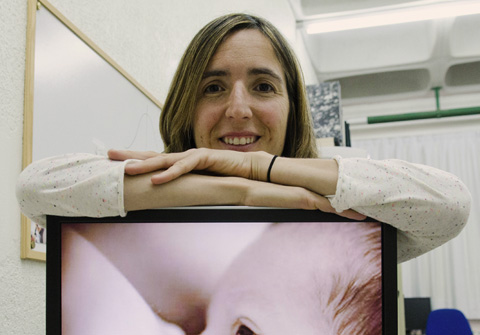Living in a city with a high level of vehicle traffic or close to a steel works means living with two intense sources of environmental pollution. However, a study conducted by the UPV/EHU researcher Aitana Lertxundi indicates that the harmful effect of PM2.5 pollution particle matter and nitrogen dioxide (NO2) disappears in breastfed babies during the first four months of life. According to the results of the research, breastfeeding plays a protective role in the presence of these two atmospheric pollutants.
Breastfeeding protects against environmental pollution
A piece of research by the UPV/EHU-University of the Basque Country analyses the effects of PM2.5 pollution particle matter and NO2 in pregnant women and their offspring
First publication date: 20/05/2015

Aitana Lertxundi has conducted her research work within the framework of the INma (Childhood and Environment) programme led by Jesús Ibarluzea of the Department of Health of the Government of the Basque Autonomous Community (region). The aim is to assess how exposure to environmental pollution during pregnancy affects health and also to examine the role of diet in physical and neurobehavioural development in infancy. Lertxundi's study focusses on the repercussions on motor and mental development during the first years of life caused by exposure to the PM2.5 and NO2 atmospheric pollutants.
Never before has such a recent, significant evaluation been made of the effect of pollution particle matter (PM2.5) on the development of motor capacity and that of nitrogen dioxide (NO2) on mental development between the prenatal phase and until the baby is 15 months old. What is more, it has been sustained over time since it was started in 2006. "In the foetal phase the central nervous system is being formed and lacks sufficient detoxification mechanisms to eliminate the toxins that build up," pointed out Aitana Lertxundi.
The PM2.5 particles measure less than 2.5 micra, in other words, they are four times thinner that a single hair and are suspended in the air. As they are so small they can easily penetrate the body and as they weigh so little they can spread without any difficulty through the air and can move far away from the initial emission source. The composition of these neurotoxic particles depends on the emission sources in the area. The INMA Gipuzkoa area under study has a high presence of neurotoxic particle matter made up of lead, arsenic and manganese from industrial activity and traffic. In comparison with urban averages where the main source of pollution is traffic, the concentration is lower.
One result of the study is that the existence of an inverse relationship has been detected between exposure to pollution particle matter and the motor development of babies. In this respect, the researcher highlights the fact that "these indices display an alteration with respect to the average and, even if they are not worrying, they are significant in that they reveal the relationship existing between air quality and motor development." The analysis of the data also shows that neither the PM2.5 particle matter nor the NO2 exert a harmful effect on babies breastfed on mother's milk for at least four months.
The monitoring study started in 2006 when the mothers were pregnant and is continuing today now that the children have reached the age of 8. So far, samples taken from 638 pregnant women and their babies when they were 15 months old have been analysed. They are inhabitants of the Goierri-Alto and Medio Urola valleys, a part of the province of Gipuzkoa where industrial activity (11 steel works), rural activity, and residential areas are interwoven with each other and through which a major highway passes.
About the author:
Aitana Lertxundi (Zarautz, 1980) is a graduate in Environmental Sciences. She has a PhD in Environmental Epidemiology from the University of Girona, Catalonia. She lectures in the Department of Preventive Medicine and Public Health of the UPV/EHU's Faculty of Medicine and Odontology. She is a researcher in the Department of Statistics and Epidemiology of the University of Florence and a CIBER researcher in the Department of Health of the Government of the Basque Autonomous Community. She has participated in Spanish and European research projects on Environmental Epidemiology.
About the article:
Aitana Lertxundi, Michela Baccini, Nerea Lertxundi, Eduardo Fano, Aritz Aranbarri, Maria Dolores Martínez, Mikel Ayerdi, Jon Álvarez, Loreto Santa-Marina, Miren Dorronsoro, Jesus Ibarluze. "Exposure to fine particle matter, nitrogen dioxide and benzene during pregnancy and cognitive and psychomotor developments in children at 15 months of age" Environment International (2015) http://dx.doi.org/10.1016/j.envint.2015.03.007

